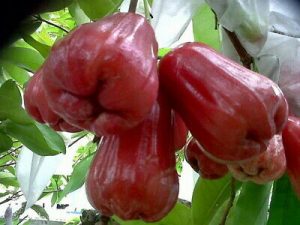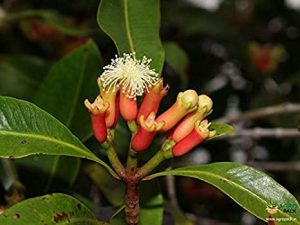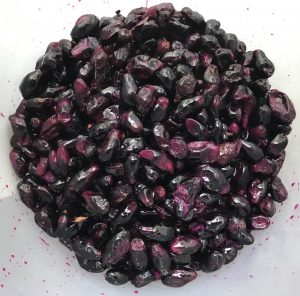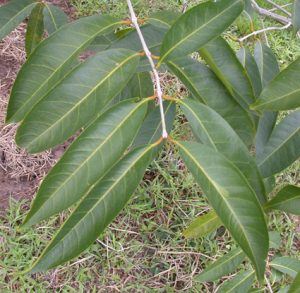
Fruits in the Syzygium genus come in make different shapes and sizes.
The apple is in the Rose family but the Rose Apple is not though it can sometime taste like rose water… and watermelon… but not apples.

The redder the Rose Apple the sweeter.
Like many fruit of Asian origin this species and relatives have dozens of common name and a few botanical ones as well: Bell Fruit, Champoo, Cloud Apple, Jamaican Apple, Java Apple, Lembu, Lian-Woo, Love Apple, Makopa, Malay Apple, Mountain Apple, Royal Apple, Water Apple, Wax Apple, and Wax Jambul. Its most significant other botanical name is/was Eugenia javanica. That should tell you two things: It’s from the Java area and is related to the Suriname Cherry and the Simpson Stopper. How closely related is a good debate. The blossoms look similar and the leaves are aromatic. The genus is Syzygium — more on that later — and there are 1,139 members in that genus including the tree that produces the spice “cloves.” You will have to take the common names, as they say, with a grain of salt in that related genus-mates often have the same names. Add to that different botanical names and it is a drunk-botanist mess.

The flower buds of one Sygyzium become cloves.
As one night surmise the Rose Apple (Syzygium samarangense) has a long history in Southeast Asia. Not only does it have a wide range it is also the most commonly cultivated tree in that area of the world. Native from Bangladesh to the Solomon Islands it’s commonly planted in Malaysia, Indonesia, Thailand Cambodia, Laos, Vietnam, Taiwan, India, Zandibar, Pemba, Surinam, the Antilles, northern Australia, and the Philippines where it is naturalized. It was intentionally introduced into Florida in 1960 and some trees can be found in Arizona and southern California. The species does not like high altitudes (must be below 4,000 feet) nor temperatures below freezing though mature trees can take 28F for a while. It likes well-drained soil, morning sun and afternoon shade if temperatures are regularly over 90F. Self-pollinating the tree easily grows from the non-edible seeds, grows very fast, and can fruit within three to five years. It is not unusual for a five-year-old tree to have 700 fruit per season. The fruit can also grow on the trunk and branches and reach maturity in 63 days. As for the fruit…

Jambul Fruit being made into wine. Photo by Green Deane
They range in color from pinkish white to deep red almost black. The darker the fruit the sweeter also the more ripe it is and the less citric and oxalic acid it has. Traditionally the bottom of the fruit is removed with the core and seeds as one often prepares a green pepper for stuffing, leaving it hollow. The fruit has more water content than an apple, on par with a watermelon, and the flesh is softer than an apple despite its name. They are eaten out of hand or made into jelly, juice, sauces and wine (fruits of different color produce different colored juice.) The fruit is a sliced addition to salads, can be pickled, and is use as a food decoration. Nutritionally per 100 grams they have about 0.3 grams of protein, no fat, 3.9 grams of carbohydrates, one gram of fiber, 253 IUs of vitamin A, traces of vitamin B1 and B2 traces, one milligram of vitamin C and 80 calories. It’s 90% water. A close relative of the Rose Apple is the Jambul or Java Plum. That is more commonly found in Central to South Florida. As far as I can tell all the species fruit at about the same time which can range locally from late July to mid-September.

Syzygiums have two equal leaves at the end of each branch.
As for the botanical name Syzygium is Latin-mangled Greek for “yoke mate.” Greeks call their spouse their yoke-mate. The genus got the name because at the end of the branch there are two equal leaves, see photo left. They are not off set but equal. It’s a good identifier. S. samaragense is more ambiguous. The central city of Java is Semarang and was perhaps named for that. S. jambous is from Indian names of that fruit (which can also means guava) and S. cumini… That’s bit more complex. It means “cumin” like the spice going back to the Greek Kimion but it also has the meaning of being a spice or a drug. The dried buds of S. aromaticum (aromatic) are “cloves.” “Clove” by the way goes back to Dead Latin and means “nail.”
Green Deane’s “Itemized” Plant Profile
IDENTIFICATION
The tree, 16 to 50 feet tall, has a short trunk, 10 to 12 inches, thick, and open, wide-spreading crown, pinkish-gray, flaking bark. Opposite leaves are nearly sessile (stem-less) elliptic-oblong, rounded or slightly heart-shaped at the base; yellowish to dark bluish-green; 4 to 10 inches long and 2 to 4 3/4 inches wide; very aromatic when crushed. Flowers drooping panicles of 3 to 30 at the branch tips or in smaller clusters in the axils of fallen leaves, fragrant, yellowish-white, 3/4 to 1 1/2 inches broad, four-petalled, with numerous stamens to one inch long. The waxy fruit, usually light-red, sometimes greenish-white or cream-colored, is pear-shaped, narrow at the base, very broad, flattened, indented and adorned with four fleshy calyx lobes at the apex; The skin is thin, the flesh white, spongy, dry to juicy, subacid and very bland in flavor. One or two somewhat rounded seeds 3/16 to 5/16 of an inch or none.
TIME OF YEAR
In its native range year round or late spring and early fall. In central Florida late July, August usually, some times September.
ENVIRONMENT
Rich, well-drained soil, morning sun, afternoon shade in hot climates, top of a hill rather than the bottom of a hill, temperatures not lower than 28F and elevations not over 4,000 feet.
METHOD OF PREPARATION
Fruit raw or cooked (not seeds.) Can be made into jelly, juice, wine, sauces, or pickled. A recipe is below.
Herb Blurb
The flowers are astringent and have been used to treat fever and diarrhea. The principal compound seems to be tannin. The fruit also contains desmethoxymatteucinol, 5-O-methyl-4′-desmethoxymatteucinol, oleanic acid and B-sitosterol and show weak antibiotic action against Staphylococcus aureus, Mycobacterium smegmatis, and Candida albicans.
Stuffed Squash Blossoms with Rose Apple Filling
Ingredients:
2 bunches (approx. 20 pieces) squash blossoms
3 tablespoons oil, divided
1 medium white onion, minced
1 cup canned button mushrooms, drained and chopped finely
Salt and ground black pepper to taste
2 tomatoes, seeded and chopped finely
4 tablespoons minced Rose Apple
1/2 cup finely cubed soft, un-aged white cheese
3 egg whites, beaten lightly
Prepare the squash blossoms: Snip off the stems, wash, and carefully pat dry with paper towels. Remove the pistil from each flower. Set aside. In pan, heat 1 tablespoon oil. Sauté the onion for a couple of minutes. Add mushrooms and cook for about 3 minutes. Remove from heat and transfer to a bowl. Add tomatoes. Season it with salt and pepper. Add makopa, mabolo, and kesong puti. Toss well. By using a teaspoon, stuff it filling into the squash blossoms. In a nonstick pan over medium heat, pour remaining oil. Dip each stuffed squash blossom into the egg whites and pan-fry, turning once to make sure both sides are cooked through.
Crunchy tip: If you want it crunchy, combine rice flour, egg white, and water to make a batter with a pancake like consistency. Dip stuffed squash blossoms into the batter and deep-fry quickly.

